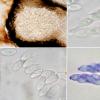
10-03-2025 22:26
 Michel Hairaud
Michel Hairaud
Bonjour, Je sollicite de l'aide pour mettre un no

11-03-2025 17:27
 Lothar Krieglsteiner
Lothar Krieglsteiner
I hope it is o.k. to ask this question here. As y

11-03-2025 18:48
 Nicolas VAN VOOREN
Nicolas VAN VOOREN
Bonjour.Je suis à la recherche d'une collection (

11-03-2025 15:18
 Bernard CLESSE
Bernard CLESSE
Bonjour à toutes et tous,Pourriez-vous m'aider à

08-03-2025 14:54
Ethan CrensonHello all, This is a recent find from New York Ci

11-03-2025 10:16
 Michel Hairaud
Michel Hairaud
Bonjour , Récolte sur tronc mort de Carpinus. Fo

10-03-2025 18:51
Juuso ÄikäsThese apparent Cryptodiscus fruitbodies with a pal

15-02-2025 22:05
 Robin Isaksson
Robin Isaksson
Hi!Anyone knows this?Conidia around 6-11 x 6-8 um,

08-03-2025 16:21
Yanick BOULANGERBonjourDialonectria episphaeria sur Diatrype stigm
Un pyrénomycète sur feuille de chêne
Michel Hairaud,
10-03-2025 22:26
 Bonjour,
Bonjour, Je sollicite de l'aide pour mettre un nom sur cette récolte d'hier.
Périthèces immergés dans la nervure centrale de la feuille ou le pétiole
Spores 14-15 x 6 µm
Asques morts longs 60 - 70 µm . Bouchon apical coloré dans le Bleu de Crésyl aqueux.
Merci
Amitiés. Michel
Alain GARDIENNET,
11-03-2025 06:45
Re : Un pyrénomycète sur feuille de chêne
Salut Michel,
Ca semble super interessant à chercher, vers les genres Gnomoniella,Dicarpella
Je creuserai la question plus tard.
Alain
Ca semble super interessant à chercher, vers les genres Gnomoniella,Dicarpella
Je creuserai la question plus tard.
Alain
Michel Hairaud,
12-03-2025 11:57

Re : Un pyrénomycète sur feuille de chêne
Merci pour ce premier avis.
''plus tard'' , c'est à quelle heure ? -:)
Michel
''plus tard'' , c'est à quelle heure ? -:)
Michel

